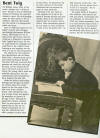(HTML text follows.)
For William James Sidis, a fine mindóperhaps one of history's bestóbecame a kind of deformity. Instead of following the expected meteoric career, the child prodigy opted for what seemed a life of mediocre obscurity that earned him the hatred of a disappointed public and press. Born in 1898 and named for his father's mentor and colleague, psychologist-philosopher William James, Sidis began his rise to fame at the age of four, when he could use a typewriter to produce both English and French. By five, he could speak five languages and read Plato in the original Greek. Learning a new language was the work of a day for the young genius. The impetus for this extraordinary development was his father, Boris Sidis, a Russian-born psychiatrist then teaching at Harvard. The elder Sidis was convinced that geniuses are made the way twigs are bent, and he showed off his son to the world as proof of his theory. But young Sidis's mind was naturally spectacular: One psychometrician later estimated his IQ at between 250 and 300. Under his father's unrelenting tutelage and the glare of publicity (stories about him would appear on the first page of the New York Times nineteen times), Sidis finished his first year of high school and applied for admission to Harvard at the age of nine. Although he passed the entrance examinations, he was rejected on the ground that he was too immature emotionally for college life. Admitted as Harvard's youngest scholar when he was eleven, he amazed his elders with a lecture on the fourth dimension that was beyond the grasp of many professors. Brilliant as he was, however, Sidis appeared to be out of his depth at Harvard socially and emotionally. Many of his classmates regarded him as eccentric and reclusive. Sidis nevertheless graduated cum laude in 1914, at sixteen. "I want to live the perfect life," he told reporters at the time. "The only way to live the perfect life is to live it in seclusion." His remarks were prophetic. He taught briefly at Houston's Rice Institute, then entered Harvard Law School. Increasingly radical politically, he left school in 1918 just before graduating. Then, as a conscientious objector and budding Marxist, he was arrested during a May Day riot in Boston and narrowly saved from jail by his parents. But the incident apparently jarred him, for from then on, he seemed to drop out of the intellectual race he had run all his life. Sidis took a series of undemanding jobs, apparently discarding all challenging pursuits. He did write one book about a hobby that became a passion: Notes on the Collection of Streetcar Transfers. He even coined a word for such collectors, peridromophiles. The press took to attacking the one-time boy wonder as a burnout who had been too smart too soon. A James Thurber article in the New Yorker in 1937 ridiculed him so savagely that Sidis sued for libel, finally winning a small out-of-court settlement. Editorials accused him of betraying the public's expectations. But, although Sidis went his own way, he never really abandoned the inner life of the mind. Instead, as one writer put it, Sidis merely took his intelligence underground. Three decades after Sidis's death in 1944 of a brain hemorrhage, a Columbia University psychology student by the name of Dan Mahony began probing the lost years of Sidis's life. After much rummaging in dusty attics, Mahony found that Sidis had in fact filled those seemingly empty years with mental activity. He had many friends, whom he amazed with such feats as doing a New York Times crossword puzzle entirely from memory after quickly reading the clues. He could translate some forty languages, and he wrote prodigiously. There were manuscripts for two books and evidence of two more, as well as eighty-nine newspaper columns written under a pen name. His sister, Helena, thought that there must be a dozen more manuscripts, including one book about the lost continent of Atlantis and a science fiction novel. One of the surviving books, The Animate and the Inanimate, published in 1925, put forward a number of precocious theories of the universe, including a description of the cosmic phenomena now called black holesócollapsed stars so dense that their powerful gravity prevents even the escape of light. Another book, a 1,200-page tome called The Tribes and the States, argued from persuasive evidence that the political system of New England was profoundly influenced by the democratic federation of its Indian tribes. Sidis's search for seclusion, some scholars now believe, came from his having adopted the teachings of the Okamakammessetts, a Massachusetts tribe that taught a principle of anonymous contribution to society. But the legacy of the man once called "the most remarkable youth in the world" was a general sense that neurotic failure was the inescapable fate of child prodigies. In fact, by jeering at his differences, the world had silenced one of its finest minds.
|
